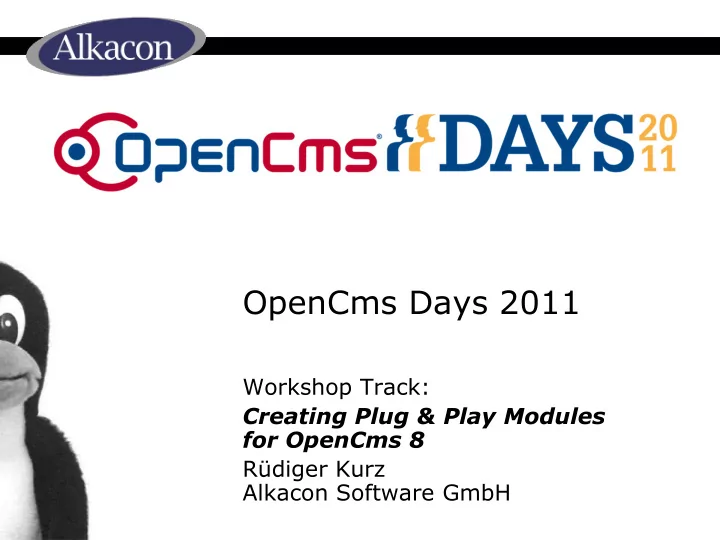

OpenCms Days 2011 Workshop Track: Creating Plug & Play Modules for OpenCms 8 Rüdiger Kurz Alkacon Software GmbH
Agenda • Developing Web-Projects in general • OpenCms Modules v7 vs. v8 • The module structure • The module contents • Creating a new module
Developing Web-Projects • There are two approaches to develop Web- Projects in general: • “Tight coupling” – You can develop a single Module encapsulating everything you need for your Web-Project – This Module will only work in your concrete project • “Loose coupling” – You can develop generic Modules realizing a single requirement inside your Web-Project – Those modules can than reused in other projects – Example: One Module for one Content-Type
OpenCms Modules v7 vs. v8 • Version 7 with Template 2 and Web-Form – Modification necessary: – Adapt the Web-Form-Module itself – Adapt your Website-Template Module-Update needs adoption of your Web- Project • Version 8 with Template 3 and Web-Form – Ready to use: – Adapting Web-Form not necessary – Adapting Website-Template not necessary Module update without any problem
The module structure
Example Scenario • Imagine you want to create a “plug & play” module that defines only one resource type • Lets call this resource type “ my_content ” • The XSD file for this resource type has the name “ content.xsd ” • Then your module should have the following folder structure…
Module Structure Module folder content model (new) sitemap config (new) formatters (new) schema for the content
The module in detail
Content Model • The content model typically relies in the module folder under: config/model • It is a XML-content instance of the XSD you defined inside your module (content.xsd) • This model is used as the default content if you create a new resource of the type my_content with the container page editor • It is referenced by the sitemap config
Sitemap Configuration • The sitemap configuration is a new resource type shipped with OpenCms 8 by default • The main function of that file is to define the resource types that are available in the container page editor • Typically this file is stored below the Site e.g. /sites/default/_config/sitemap.config • For creating a “plug & play” module we put a sitemap configuration in the module • The path to this sitemap configuration file has to be configured as module parameter ( config.sitemap ): config.sitemap =/system/modules/…/ sitemap.config
Sitemap Configuration • Sitemap configurations can rely inside the Module or inside a Sitemap • When the “ container page editor ” tries to determine which configuration to take, it looks inside the module and in the Sitemap • That makes it possible to configure a default behavior for a fresh module installation • If the “ container page editor ” finds a configuration on both locations the Sitemap is stronger
Sitemap Configuration The field : „ Source file „ The field : „ Pattern „ points on the content model. defines the file pattern. That tells the container page That tells the container page editor which content to use editor which file name to use as default. for new contents.
Formatters as Key-Technique • The formatter‟s concept is the key technique for creating “plug & play” modules • Formatters can be configured for each resource-type • This is typically done in the XSD • The new configuration allows to specify attributes that tell the formatter into which container it fits: – uri: The path to the formatter JSP – type : specifies the type of the container the formatter is compatible with – minwidth : The minimum width the container must have to hold the formatter – maxwidth : The maximum width the container must have to hold the formatter
Formatters as Key-Technique • Define a formatter: […] <xsd:annotation> <xsd:appinfo> […] <formatters> <formatter uri="/path/to/JSP" type="*" minwidth= " 100 " maxwidth= " 500 “ /> </formatters> […] </xsd:appinfo> </xsd:annotation> […]
Formatters as Key-Technique • By setting the type to “*” the formatter can be used for each container • The attributes minwidth and maxwidth restrict this formatter to be used in containers whose width is in-between • A JSP that uses the <cms:formatter> -tag can access the configured width of the container • … and can then change the presentation of a content dynamically • That makes it possible to create formatters without any knowledge of the template
Formatters as Key-Technique <%@page buffer="none" session="false" taglibs="c,cms “%> <cms:formatter var="content" val="value"> <div class="view-article"> <h2>${value.Title}</h2> <div class="paragraph"> <c:set var="imgwidth"> ${((cms.container.width) / 2) - 25} </c:set> <cms:img src="${value.Image}" width="${imgwidth}"/> ${value.Text} </div> </div> </cms:formatter>
Formatters as Key-Technique • In spite of the power of formatters it can happen that you use a third party module that won„t work with your template • In that case it is possible to write and configure your own formatter without changing the third party module • Advantage : You can update the third party module without changes
Create a new module
Creating a new module • Create a module with the OpenCms workplace as usual • Create the folder structure inside the module • Create a XSD schema for the content you want to offer with your module • Configure the resource type and the explorer type as usual in the opencms-modules.xml • Create a default content for the newly created schema
Creating a new module • Create a formatter that renders the content • Add the formatter to the XSD of your content • Create a sitemap configuration file with the help of the new wizard of OpenCms • Edit the Sitemap configuration and set in the field “Source file” the path to your default content inside the module • Set in the field “Pattern” the pattern you want to have for new files (c_%(number).html) • Create a module parameter: config.sitemap =/system/modules/…/ your.sitemap.config
Live Demo Demo Demo Demo Demo
Questions Questions ? Fragen? ¿Preguntas? Questiones?
Thank you very much for your attention Rüdiger Kurz Alkacon Software http://www.alkacon.com http://www.opencms.org
Recommend
More recommend